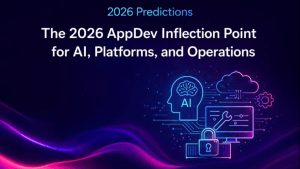In the rush to stay competitive, enterprises have turned to the public cloud for quick and easy AI experimentation. Public-cloud services make it simple to spin up proofs-of-concept, test them, and discard them if they don’t deliver the expected results. While this can work at the pilot stage, it often leads to surprising cost spikes, compliance complications, and security headaches once you move from experimenting to running AI at scale.
Last November we put forth the premise that massive untapped opportunities exist within enterprises to bring AI in house and apply intelligence to their own data. While many firms discuss proprietary data as the linchpin of this opportunity, very few in our view have successfully brought AI to their own enterprises. But the imperative remains. Industries such as financial services, healthcare, life sciences, and defense must safeguard highly sensitive data. Concerns about data gravity, sovereignty, and latency make off-premises cloud environments less appealing—or outright off-limits—for their production AI workloads. Yet on-premises AI adoption remains slower than anticipated. Why? Because deploying AI internally is not as simple as buying a few servers: it requires a well-structured roadmap, skilled talent, budget commitment, clear value and the right organizational culture.
In this research note, we explore the major barriers to on-prem AI adoption, the missed opportunities of leaving enterprise data unused (or pushing it to external services), and why organizations should consider establishing internal AI centers of excellence to build competitive advantage.
The Hurdle: Slow Enterprise AI Adoption
As of last fall, shown by the following ETR data, nearly 80% of enterprises reported they were still in the evaluation phase with generative AI initiatives. While progress is being made, based on dozens of conversations conducted by theCUBE Research, this picture hasn’t changed dramatically.

Most of this evaluation has occurred in the public cloud. and organizations have been slow to bring AI to their proprietary on-prem data. Below we cite four key barriers:
Capital Investment and Unclear ROI
Enterprises worry about dedicating substantial capital to build and maintain AI infrastructure, especially if leadership doesn’t see a clear business case. Many rely on vague assumptions about cost savings or efficiency gains instead of concrete, data-driven outcomes. This uncertainty stalls decision-making and can keep teams tied to purely cloud-based pilots.
Skill Gaps and Operational Complexity
Running AI at scale in-house isn’t just about purchasing servers and GPUs. From specialized software stacks to data engineering pipelines, the complexity can be challenging for organizations. Finding (and retaining) skilled people who understand machine learning, large language models, and cutting-edge data infrastructure also remains a challenge.
Cloud vs. On-Prem Tension
It’s easy to rely on the public cloud for early experiments—spinning up and down resources without big, upfront costs. But once enterprises need consistent, large-scale training or inference capabilities, cloud expenditures can skyrocket, becoming both unpredictable and unsustainable. On-premises and/or hybrid infrastructure offers more cost control in the long run, especially when data volumes are high or data must remain in-house due to privacy regulations.
Startup Ecosystem Misalignment
Many AI startups develop their solutions natively in the cloud and are slow to optimize for on-prem environments. This misalignment discourages enterprises seeking hybrid or fully on-prem solutions from adopting new AI technologies. The result? Potentially transformative AI applications remain stuck in “proof-of-concept limbo,” never reaching production on company-owned infrastructure.
Opportunity: Leveraging Internal Data
Publicly available datasets are fine for generic use cases or initial tests, but true competitive advantage comes from proprietary data—customer interactions, transaction histories, operational metrics, and the like. By keeping AI tied only to public datasets or ephemeral cloud demos, organizations fail to capitalize on the unique insights locked in their own data stores.
Moreover, industries with strict data regulations can’t simply outsource their AI to a public cloud model that resides outside their direct control. Even if the technology works, compliance teams often balk at the risk. Implementing robust, in-house AI infrastructure ensures data never leaves the organization’s four walls, satisfying regulatory requirements and mitigating security concerns.
Once AI workloads scale, computing on your own hardware often becomes more predictable and cost-effective. Organizations can size their on-prem infrastructure to align with typical usage patterns, thereby avoiding runaway cloud bills. Additionally, local data access can reduce latency, resulting in faster analytics or real-time inference that can be business-critical.
The Case for Building an Internal AI Center of Excellence
To overcome these hurdles and fully tap into the power of proprietary data, we advise enterprises to stand up a dedicated AI Center of Excellence (CoE). Think of it as a specialized, internal “lab” or program that address the following four value points:
- Develop a Reference Architecture
- Provide guidelines on how to handle everything from data integration and storage tiers to model training and deployment.
- Offer best practices for cost-effective footprints that still deliver powerful outcomes for AI tasks.
- Close the Skill Gap
- Centralize AI expertise, from data scientists and ML engineers to solution architects.
- Train cross-functional teams and cultivate knowledge-sharing so AI maturity spreads throughout the organization.
- Document ROI and Use Cases
- Provide proofs of concept that show real business impact—cost reduction, revenue growth, risk mitigation—making it easier for leadership to justify broader adoption.
- Develop benchmarks and success metrics that de-risk on-prem AI initiatives for other lines of business.
- Foster a Hybrid Ecosystem
- Collaborate with AI software vendors or startups to tailor their cloud-centric solutions to work in on-prem environments.
- Strengthen the ability to support hybrid models, so the enterprise can keep sensitive data on-prem while leveraging the cloud where it makes sense.
Practical Phases to Scale AI In-House
Standing up your own AI Center of Excellence can be approached in pragmatic phases:
- Initial Pilot
- Establish a small but representative AI infrastructure cluster.
- Validate a handful of high-impact AI workloads (such as customer care or foundational language models) on real internal data.
- Publish early case studies internally to build momentum.
- Refine & Benchmark
- Expand the AI lab’s capabilities: test more complex or specialized AI use cases.
- Measure performance and cost metrics vs. the public cloud.
- Establish standardized benchmarks for common workloads like supply chain optimization or risk analysis.
- Scale Across the Enterprise
- Onboard additional business units and functional teams to the on-prem AI platform.
- Develop a repeatable “CoE in a Box” blueprint, including hardware configurations, software stacks, and workflows.
- Start to formalize the ROI story—both for cost savings and for revenue-generating, data-driven products or services.
Managing Risk
The upfront investment for an on-prem AI environment can be substantial. Forward-leaning organizations see the strategic, long-term imperative but clear business cases should include risk management. The following four areas can serve as dimensions for justifications with upper managements:
- Predictable Total Cost of Ownership (TCO): Research the impact of avoiding “meter running” scenarios in the cloud by designing infrastructure around known workloads that deliver tangible value.
- Data Security: Reduce breaches and compliance issues by controlling your data end-to-end.
- Performance Optimization: Run latency-sensitive AI locally, gaining speed advantages that can directly impact user experience or operational efficiency, driving better customer outcomes.
- Ownership of Intellectual Property: Retain full rights to any models trained on your internal data, without risking exposure or lock-in.
Conclusion: Get Your Data House in Order to Differentiate
Enterprises that continue relying solely on public-cloud AI experiments risk missing out on the real business transformations AI can enable. The largest untapped resource is the data you already own—rich with insights specific to your customers, operations, and market. Bringing AI in-house solves the sovereignty challenge and enables you to deliver strong results without the unpredictability of spiraling cloud expenses.
Adopting on-prem AI is more complex than running a quick cloud pilot. But by building a structured AI Center of Excellence—from a small pilot to a repeatable organization-wide program—companies can gradually master the learning curve, secure long-term ROI, and sharpen their competitive edge. The message to management should be the future belongs to enterprises that harness the power of their own data on their own terms.
It’s time to bring AI home but do so with a clear plan for attaining value.



